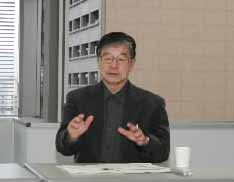Hibakusha to meet survivors of the My Lai Massacre
Feb. 19, 2008
by Hiromi Morita, Staff Writer
In March, a memorial ceremony will be held in My Lai, central Vietnam, to commemorate the 40th anniversary of the My Lai Massacre which involved the killing of a large number of civilians during the Vietnam War. Five A-bomb survivors, including Shoji Sawada, Professor Emeritus of Nuclear Physics at Nagoya University, will attend the ceremony. They plan to share experiences with survivors of the massacre, as well as U.S. veterans, to explore issues of peace.
As the My Lai Peace Park Project website states, both Hiroshima/Nagasaki and My Lai are “terrible killings grounds, both have been ignored by the U.S. government, both still suffer the long-term effects of weapons which were different in nature but left a similar legacy; radiation and Agent Orange have resulted in high death rates from cancer and genetic damage which continue to be passed on generation after generation.”
A delegation of about 50 people, composed of the five A-bomb survivors, students, and citizens, will leave Japan on March 14 and participate in the ceremony on March 16. They will observe several projects that have been implemented by U.S. veterans of the Vietnam War after reflecting on their role in this conflict. These projects involve providing support to the people of Vietnam by alleviating poverty and establishing peace parks. Members of the delegation will also meet victims of Agent Orange in Hanoi and Ho Chi Minh then return to Japan on March 21.
Professor Sawada experienced the atomic bombing of Hiroshima when he was in his second year of high school. He will share his personal account of fleeing from the fire of the bombing and being forced to leave his mother behind. An exhibit on the atomic bombings is also planned. Professor Sawada expressed his enthusiasm for this trip, stating “I look forward to relating my experience of the A-bomb and stressing the foolishness of war.”
The visit is organized as the “Trip Linking My Lai, Hiroshima, and Nagasaki” by Professor Sawada and Professor Hiroshi Fujimoto, a historian of U.S. Diplomacy at Nanzan University. They learned about the ceremony through a U.S. veteran whom they met at a meeting of the World Conference Against Atomic and Hydrogen Bombs and have invited A-bomb survivors and students to take part in the trip.
Keywords
My Lai Massacre
In 1968, in the midst of the Vietnam War, a platoon of American soldiers led by Lieutenant William Calley attacked the hamlets of My Lai and My Khe of Son My village. Though they had believed the area was a stronghold of the National Front for the Liberation of South Vietnam, the remaining inhabitants were civilians, the majority of them women and children. Nevertheless, Calley ordered his men to kill them and a massacre of unarmed villagers took place. The incident was revealed the following year and caused an outcry throughout the world.
In March, a memorial ceremony will be held in My Lai, central Vietnam, to commemorate the 40th anniversary of the My Lai Massacre which involved the killing of a large number of civilians during the Vietnam War. Five A-bomb survivors, including Shoji Sawada, Professor Emeritus of Nuclear Physics at Nagoya University, will attend the ceremony. They plan to share experiences with survivors of the massacre, as well as U.S. veterans, to explore issues of peace.
As the My Lai Peace Park Project website states, both Hiroshima/Nagasaki and My Lai are “terrible killings grounds, both have been ignored by the U.S. government, both still suffer the long-term effects of weapons which were different in nature but left a similar legacy; radiation and Agent Orange have resulted in high death rates from cancer and genetic damage which continue to be passed on generation after generation.”
A delegation of about 50 people, composed of the five A-bomb survivors, students, and citizens, will leave Japan on March 14 and participate in the ceremony on March 16. They will observe several projects that have been implemented by U.S. veterans of the Vietnam War after reflecting on their role in this conflict. These projects involve providing support to the people of Vietnam by alleviating poverty and establishing peace parks. Members of the delegation will also meet victims of Agent Orange in Hanoi and Ho Chi Minh then return to Japan on March 21.
Professor Sawada experienced the atomic bombing of Hiroshima when he was in his second year of high school. He will share his personal account of fleeing from the fire of the bombing and being forced to leave his mother behind. An exhibit on the atomic bombings is also planned. Professor Sawada expressed his enthusiasm for this trip, stating “I look forward to relating my experience of the A-bomb and stressing the foolishness of war.”
The visit is organized as the “Trip Linking My Lai, Hiroshima, and Nagasaki” by Professor Sawada and Professor Hiroshi Fujimoto, a historian of U.S. Diplomacy at Nanzan University. They learned about the ceremony through a U.S. veteran whom they met at a meeting of the World Conference Against Atomic and Hydrogen Bombs and have invited A-bomb survivors and students to take part in the trip.
Keywords
My Lai Massacre
In 1968, in the midst of the Vietnam War, a platoon of American soldiers led by Lieutenant William Calley attacked the hamlets of My Lai and My Khe of Son My village. Though they had believed the area was a stronghold of the National Front for the Liberation of South Vietnam, the remaining inhabitants were civilians, the majority of them women and children. Nevertheless, Calley ordered his men to kill them and a massacre of unarmed villagers took place. The incident was revealed the following year and caused an outcry throughout the world.








